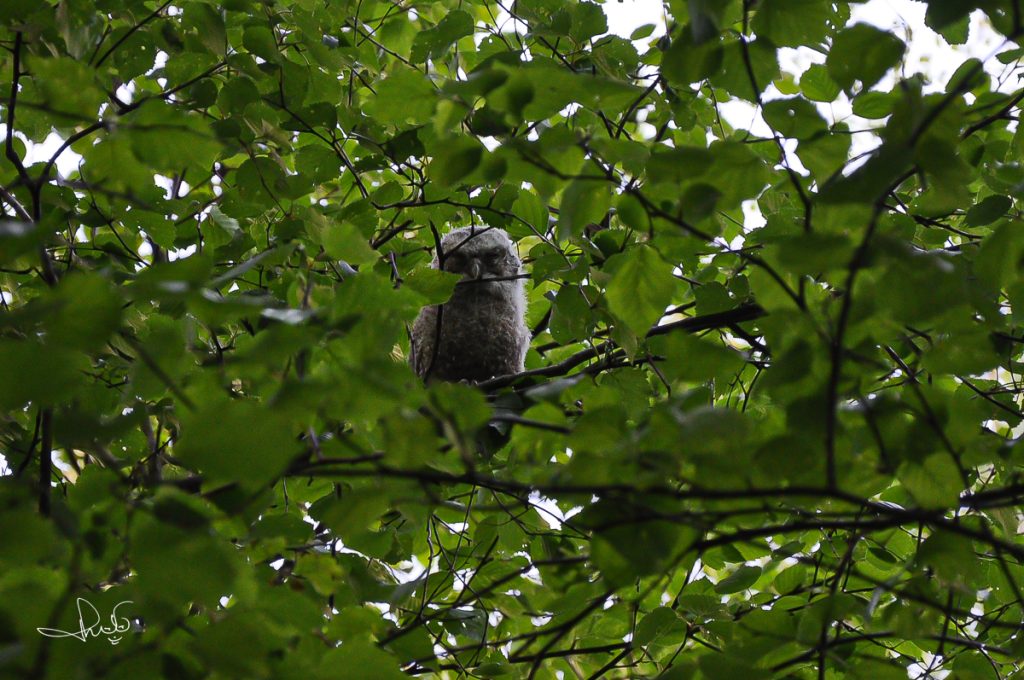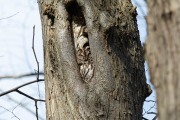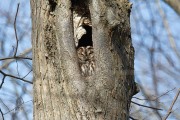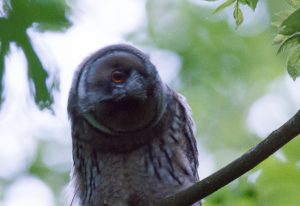Two days ago, on March 20th, astronomical spring began. And that is also noticeable in nature. Soon the nesting boxes in the garden will be explored and busy times are coming for the birds: nest building, courtship, mating, egg laying, brooding and feeding the young. However, for some birds this time has already come. They don’t wait until spring arrives but are already busy with family planning. The cormorant (Phalacrocorax carbo) sometimes start laying eggs as early as December and when the breeding season kicks off in full force, this bird is often already on its second brood. Another – literally – early bird is the tawny owl (Strix aluco), which plays the main role in this blog.
Doubling
Chances are you have never seen a tawny owl even though it is the most common owl species in Europe. In the Netherlands, the species is clearly on the rise. In the 1960s, the tawny owl was mainly found in the west of the Netherlands. From the mid-1970s, the population expanded to the provinces of North Brabant and Drenthe. In the 1990s and early 2000s, the numbers remained fairly stable, only to show an increase again after 2010. The emphasis is on the provinces of South Holland, Utrecht, Gelderland, North Brabant, Limburg and Overijssel. The species is also increasing in Drenthe. In Groningen, Friesland and Zeeland, the tawny owl is less common as a breeding bird and in Flevoland it is almost completely absent. According to Sovon Bird Research Netherlands, the number of breeding pairs has doubled since 1985. It is estimated that there are now approximately 5200 to 6400 breeding pairs in our country.
Movie owl
Tawny owls are fairly shy and like to hide in a hollow tree during the day. So they are not, like long-eared owls (Asio otus), roosting in groups in trees. Sometimes the tawny owl enjoys the sun in the opening of the tree cavity, as in the photos below. But even if you know where the hole is, you sometimes have to look closely to spot the bird. While you may never have seen a tawny owl, you’ve probably heard one. Perhaps not in the wild, but when watching a scary movie. In scenes that take place in the woods at night, the sound of a tawny owl is often used to make the scene even more exciting. Just listen below, you will probably recognise it. The tawny owl therefore has a supporting role in many films, without the bird being mentioned in the credits. The sound of the tawny owl always reminds me of a holiday in France. We were in a gîte rural on a slope and looked out over the wooded valley. Every evening we enjoyed the tawny owls calling from different angles. It did not evoke any association with a scary film, it was pure enjoyment!
Hunting by ear
The tawny owl is about 37 to 43 centimeters tall and is therefore slightly larger than the long-eared owl and the barn owl (Tyto alba). The tawny owl has no ear tufts like the long-eared owl does. Similar to other owls, they sleep during the day and hunt at night. Mainly looking for mice and voles, they need about two a night to satisfy their hunger. In the absence of these rodents, tawny owls mainly catch birds. The latter is particularly common in tawny owls in urban areas. Other mammals (up to the size of young rabbits), large insects, frogs, toads and earthworms are also on its menu. Many owl species do not hunt by sight, but by ear. Contrary to what many of you may think, most owl species don’t have better night vision than we humans do. They can hear very well and because of their asymmetrically placed ears they can also flawlessly determine where the sound comes from. They can even hear a mouse crawling under a layer of snow! By the way, those ears are not on the side of the head, but right next to the eyes. You can see this in a photo in my blog about the long-eared owl. The feathered face, the mask, acts as a kind of parabolic antenna to ensure that the captured sound reaches the ears even better.
Friends for life
Tawny owls often start their courtship before Christmas. The male tries to lure a female and entice it to mate with its song. You can see and hear it in the video below.
Incidentally, the courtship is often only to seduce a female and she no longer needs to be lured. Tawny owls stay together throughout their lives, but also in the same territory. Only when one of the two dies does the remaining owl look for a new partner.
The baby of the bunch
Due to the early courtship, the tawny owls also start laying eggs early. The nest is in a natural cavity of large trees, such as old beeches or pollarded trees. Or in a special tawny owl box. That is a kind of oversized nest box with an entry hole with a diameter of 13 centimeters. At the end of January some nests already contain eggs. Usually the female lays two to four eggs but there are also nests with only one egg and sometimes with five to seven eggs. The eggs are incubated by the female, which takes about a month. Incubation starts after the second or third egg, which means that the first two or three young hatch almost simultaneously. With more than three eggs, the remaining young will hatch at two-day intervals, which is often reflected in the development of the young. Especially the youngest from the nest is clearly smaller than his brothers and sisters that hatched from the first three eggs.
Owlets
The young remain in the nest for about a month. Although, in the nest… After 1-3 week(s), they apparently have grown tired of being confined to it and go on a journey of discovery like the young in the photo below. As with the long-eared owl, the young in this adventurous stage are called owlets. They clamber over and jump onto the branches surrounding the nest. They make frantic attempts to fly, but it’s more falling. Their wings are not yet developed enough to be able to fly. Although they do flap their wings to break the fall a bit. And if they fall a little too deep and end up on the ground, they climb back up against the trunk. They use their beak and claws as crampons. If you ever come across a young tawny owl sitting on the ground, just leave it alone. As long as there is nothing wrong with it, the owlet does not need to be taken to a bird sanctuary. It will scramble back to the nest on its own. If in doubt, leave the owl chick where it is and consult with the animal ambulance or bird rehabilitation centre. So don’t take it home first.

On their own
The owlets are fed by the parents for a few more weeks, until they can fly and hunt on their own. Then they hang around the parents for about three months. After that the young owls have to find a territory themselves. With some gentle pressure, the youngsters are driven out of the living area of mom and dad, after which the parents are left with an ’empty nest syndrome’. Of course they miss that commotion of their offspring. The young tawny owls do not travel that far from their parents and generally look for their new territory less than ten kilometres from their parental nest. In very exceptional cases, the parent couple can start a second clutch. In mid-May 2019, a pair of tawny owls started in a nesting box in Blaricum (in the province of Noord-Holland) to a second clutch. Before that they had already successfully reared two young, which had left the nest on February 26. Sometimes tawny owls start again after a failed brood. But two successful clutches in a year like this is really unique.
Sources (in Dutch):
- Wikipedia
- Vogelbescherming Nederland
- Sovon Vogelonderzoek Nederland
- Sovon Vogelonderzoek Nederland – distribution area (via Instagram)
This blog was originally published in Dutch on February 2nd 2023.









Thanks a lot. I heard an owl tonight for the second time in urban Amsterdam and I identified the sound of a tawny owl or maybe 2? Looking for a mate in late October maybe? Exciting to have an owl in the neighbourhood. Great to learn more!
Thanks Fleur. It could be a tawny owl, they’re already looking for a mate. That is possible.
I live in a fairly wooded area of the town in East Lancashire UK I have heard and seen tawny owls on several occasions. Once I was looking through a window on my upper floor when a tawny owl crasher aginst the pane and would have got me but for the protection of the glass. l was very interested in your article and learned more about the bird. Thanks. Ernie Jackson 90 yrs
Thanks for your kind words, Ernie. And what an experience with that tawny owl. I hope the bird wasn’t hurt.
Really interesting Theo, a very enjoyable read, thank you.
Thanks for your kind words Lindy! 🙂